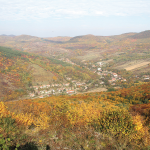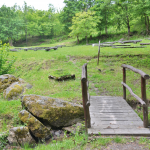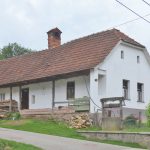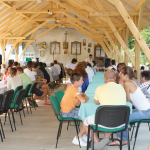Komlóska, County Borsod Abaúj Zemplén, Hungary
Komlóska is a village with some 300 inhabitants. It is located in the North of the Tokaj wine region, at the foot of the Zemplín Mountains. The entire community is part of a Natura 2000 area. The village’s history is tightly connected to the Ruthenians, a Slavic ethnic group with greek catholic belief. The Ruthenians lived in peace among the Hungarians in Komlóska for several hundred years. After World War II, the Ruthenians – almost one third of the village’s population – were relocated. Only a small minority remained behind and preserved their language and belief despite the extensive assimilation.
By the end of the 1940s, Komlóska was set to be dissolved completely. The municipality’s self-preservation was revoked and economic activity was prohibited. Only by 1990 the municipality reclaimed its self-preservation and from then on, the dynamic development of the location was promoted – even before subsidies for village renewal existed. The first aim was to remedy deficiencies through the involvement of the entire population as well as all the civil society groups, the local economy and the church.
Diverse initiatives have been created ever since. These initiatives mainly focus on agriculture, the economy and environmental protection. The village administration supports the production and sell of agricultural products by creating an umbrella brand. Additionally, it helps young families to start companies and to purchase small facilities for the refinement of local products such as fruit juice or goat cheese. Main customers for these foods are local and regional factory canteens.
The village has dedicated itself to a remarkable list of measures. For example, the project “ZeNa – Zemplen Centre for Sustainability” in Komlóska succeeds to provide environmental education for children and adolescents from Hungary’s larger cities. A bus owned by the municipality provides more mobility for the inhabitants. There are village-adornment-days and competitions during which the cleanest and best-tended houses are awarded. These measures motivate the population to maintain the village’s appearance. The Zemplener Thoughts “Cum Deo”, a series of speeches held at the local church offer intellectual nourishment, as does the music festival “Everything Nature!” The foundation “Pro Komlóska“ supports the socially disadvantaged, allocates scholarships and funds locally relevant research projects.
Another main aspect is a proper infrastructure. Aside from installing lines for cable television and internet, Komlóska also initiated a movement that fights for the preservation of smaller post office outlets all over Hungary. Maintaining traditions – Hungarian ones as well as Rutehnian – is also of great value. At the Ruthenian culture and leisure center, a renovated typical Ruthenian country house provides an authentic presentation of the ethnic group’s culture.
The exemplary care for the maintenance of traditions as well as the active involvement of all social groups are major contributions to the village life. These measures, the planned ecological industrial park and innovative economic impulses have led to pioneering development.
Evaluated: 2014





